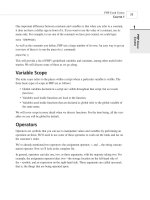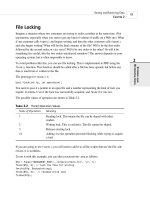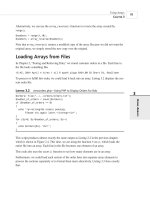Phát triển web với PHP và MySQL - p 6 pps
Bạn đang xem bản rút gọn của tài liệu. Xem và tải ngay bản đầy đủ của tài liệu tại đây (570.38 KB, 10 trang )
One important difference between constants and variables is that when you refer to a constant,
it does not have a dollar sign in front of it. If you want to use the value of a constant, use its
name only. For example, to use one of the constants we have just created, we could type:
echo TIREPRICE;
As well as the constants you define, PHP sets a large number of its own. An easy way to get an
overview of these is to run the phpinfo() command:
phpinfo();
This will provide a list of PHP’s predefined variables and constants, among other useful infor-
mation. We will discuss some of these as we go along.
Variable Scope
The term scope refers to the places within a script where a particular variable is visible. The
three basic types of scope in PHP are as follows:
• Global variables declared in a script are visible throughout that script, but not inside
functions.
• Variables used inside functions are local to the function.
• Variables used inside functions that are declared as global refer to the global variable of
the same name.
We will cover scope in more detail when we discuss functions. For the time being, all the vari-
ables we use will be global by default.
Operators
Operators are symbols that you can use to manipulate values and variables by performing an
operation on them. We’ll need to use some of these operators to work out the totals and tax on
the customer’s order.
We’ve already mentioned two operators: the assignment operator, =, and ., the string concate-
nation operator. Now we’ll look at the complete list.
In general, operators can take one, two, or three arguments, with the majority taking two. For
example, the assignment operator takes two—the storage location on the left-hand side of
the = symbol, and an expression on the right-hand side. These arguments are called operands,
that is, the things that are being operated upon.
PHP Crash Course
C
HAPTER 1
1
PHP CRASH
COURSE
25
03 7842 CH01 3/6/01 3:39 PM Page 25
Arithmetic Operators
Arithmetic operators are very straightforward—they are just the normal mathematical opera-
tors. The arithmetic operators are shown in Table 1.1.
TABLE 1.1 PHP’s Arithmetic Operators
Operator Name Example
+ Addition $a + $b
- Subtraction $a - $b
* Multiplication $a * $b
/ Division $a / $b
% Modulus $a % $b
With each of these operators, we can store the result of the operation. For example
$result = $a + $b;
Addition and subtraction work as you would expect. The result of these operators is to add or
subtract, respectively, the values stored in the $a and $b variables.
You can also use the subtraction symbol, -, as a unary operator (that is, an operator that takes
one argument or operand) to indicate negative numbers. For example
$a = -1;
Multiplication and division also work much as you would expect. Note the use of the asterisk
as the multiplication operator, rather than the regular multiplication symbol, and the forward
slash as the division operator, rather than the regular division symbol.
The modulus operator returns the remainder of dividing the $a variable by the $b variable.
Consider this code fragment:
$a = 27;
$b = 10;
$result = $a%$b;
The value stored in the $result variable is the remainder when we divide 27 by 10; that is, 7.
You should note that arithmetic operators are usually applied to integers or doubles. If you
apply them to strings, PHP will try and convert the string to a number. If it contains an “e” or
an “E”, it will be converted to a double; otherwise it will be converted to an int. PHP will look
for digits at the start of the string and use those as the value—if there are none, the value of the
string will be zero.
Using PHP
P
ART I
26
03 7842 CH01 3/6/01 3:39 PM Page 26
String Operators
We’ve already seen and used the only string operator. You can use the string concatenation
operator to add two strings and to generate and store a result much as you would use the addi-
tion operator to add two numbers.
$a = “Bob’s “;
$b = “Auto Parts”;
$result = $a.$b;
The $result variable will now contain the string “Bob’s Auto Parts”.
Assignment Operators
We’ve already seen =, the basic assignment operator. Always refer to this as the assignment
operator, and read it as “is set to.” For example
$totalqty = 0;
This should be read as “$totalqty is set to zero”. We’ll talk about why when we discuss the
comparison operators later in this chapter.
Returning Values from Assignment
Using the assignment operator returns an overall value similar to other operators. If you write
$a + $b
the value of this expression is the result of adding the $a and $b variables together. Similarly,
you can write
$a = 0;
The value of this whole expression is zero.
This enables you to do things such as
$b = 6 + ($a = 5);
This will set the value of the $b variable to 11. This is generally true of assignments: The value
of the whole assignment statement is the value that is assigned to the left-hand operand.
When working out the value of an expression, parentheses can be used to increase the
precedence of a subexpression as we have done here. This works exactly the same way as in
mathematics.
PHP Crash Course
C
HAPTER 1
1
PHP CRASH
COURSE
27
03 7842 CH01 3/6/01 3:39 PM Page 27
Combination Assignment Operators
In addition to the simple assignment, there is a set of combined assignment operators. Each of
these is a shorthand way of doing another operation on a variable and assigning the result back
to that variable. For example
$a += 5;
This is equivalent to writing
$a = $a + 5;
Combined assignment operators exist for each of the arithmetic operators and for the string
concatenation operator.
A summary of all the combined assignment operators and their effects is shown in Table 1.2.
TABLE 1.2 PHP’s Combined Assignment Operators
Operator Use Equivalent to
+= $a += $b $a = $a + $b
-= $a -= $b $a = $a - $b
*= $a *= $b $a = $a * $b
/= $a /= $b $a = $a / $b
%= $a %= $b $a = $a % $b
.= $a .= $b $a = $a . $b
Pre- and Post-Increment and Decrement
The pre- and post- increment (++) and decrement ( ) operators are similar to the += and -=
operators, but with a couple of twists.
All the increment operators have two effects—they increment and assign a value. Consider the
following:
$a=4;
echo ++$a;
The second line uses the pre-increment operator, so called because the ++ appears before the
$a. This has the effect of first, incrementing $a by 1, and second, returning the incremented
value. In this case, $a is incremented to 5 and then the value 5 is returned and printed. The
value of this whole expression is 5. (Notice that the actual value stored in $a is changed: We
are not just returning $a + 1.)
Using PHP
P
ART I
28
03 7842 CH01 3/6/01 3:39 PM Page 28
However, if the ++ is after the $a, we are using the post-increment operator. This has a differ-
ent effect. Consider the following:
$a=4;
echo $a++;
In this case, the effects are reversed. That is, first, the value of $a is returned and printed, and
second, it is incremented. The value of this whole expression is 4. This is the value that will be
printed. However, the value of $a after this statement is executed is 5.
As you can probably guess, the behavior is similar for the operator. However, the value of
$a is decremented instead of being incremented.
References
A new addition in PHP 4 is the reference operator, & (ampersand), which can be used in con-
junction with assignment. Normally when one variable is assigned to another, a copy is made
of the first variable and stored elsewhere in memory. For example
$a = 5;
$b = $a;
These lines of code make a second copy of the value in $a and store it in $b. If we subse-
quently change the value of $a, $b will not change:
$a = 7; // $b will still be 5
You can avoid making a copy by using the reference operator, &. For example
$a = 5;
$b = &$a;
$a = 7; // $a and $b are now both 7
Comparison Operators
The comparison operators are used to compare two values. Expressions using these operators
return either of the logical values
true or false depending on the result of the comparison.
The Equals Operator
The equals comparison operator, == (two equal signs) enables you to test if two values are
equal. For example, we might use the expression
$a == $b
to test if the values stored in $a and $b are the same. The result returned by this expression will
be true if they are equal, or false if they are not.
PHP Crash Course
C
HAPTER 1
1
PHP CRASH
COURSE
29
03 7842 CH01 3/6/01 3:39 PM Page 29
It is easy to confuse this with =, the assignment operator. This will work without giving an
error, but generally will not give you the result you wanted. In general, non-zero values evalu-
ate to true and zero values to false. Say that you have initialized two variables as follows:
$a = 5;
$b = 7;
If you then test $a = $b, the result will be true. Why? The value of $a = $b is the value
assigned to the left-hand side, which in this case is 7. This is a non-zero value, so the expres-
sion evaluates to true. If you intended to test $a == $b, which evaluates to false, you have
introduced a logic error in your code that can be extremely difficult to find. Always check your
use of these two operators, and check that you have used the one you intended to use.
This is an easy mistake to make, and you will probably make it many times in your program-
ming career.
Other Comparison Operators
PHP also supports a number of other comparison operators. A summary of all the comparison
operators is shown in Table 1.3.
One to note is the new identical operator, ===, introduced in PHP 4, which returns true only if
the two operands are both equal and of the same type.
TABLE 1.3 PHP’s Comparison Operators
Operator Name Use
== equals $a == $b
=== identical $a === $b
!= not equal $a != $b
<> not equal $a <> $b
< less than $a < $b
> greater than $a > $b
<= less than or equal to $a <= $b
>= greater than or equal to $a != $b
Logical Operators
The logical operators are used to combine the results of logical conditions. For example, we
might be interested in a case where the value of a variable, $a, is between 0 and 100. We
would need to test the conditions $a >= 0 and $a <= 100, using the AND operator, as follows
$a >= 0 && $a <=100
Using PHP
P
ART I
30
03 7842 CH01 3/6/01 3:39 PM Page 30
PHP supports logical AND, OR, XOR (exclusive or), and NOT.
The set of logical operators and their use is summarized in Table 1.4.
TABLE 1.4 PHP’s Logical Operators
Operator Name Use Result
! NOT !$b Returns true if $b is false, and vice versa
&& AND $a && $b Returns true if both $a and $b are true; other-
wise false
|| OR $a || $b Returns true if either $a or $b or both are true;
otherwise false
and AND $a and $b Same as &&, but with lower precedence
or OR $a or $b Same as ||, but with lower precedence
The and and or operators have lower precedence than the && and || operators. We will cover
precedence in more detail later in this chapter.
Bitwise Operators
The bitwise operators enable you to treat an integer as the series of bits used to represent it.
You probably will not find a lot of use for these in PHP, but a summary of bitwise operators is
shown in Table 1.5.
TABLE 1.5 PHP’s Bitwise Operators
Operator Name Use Result
& bitwise AND $a & $b Bits set in $a and $b are set in the result
| bitwise OR $a | $b Bits set in $a or $b are set in the result
~ bitwise NOT ~$a Bits set in $a are not set in the result,
and vice versa
^ bitwise XOR $a ^ $b Bits set in $a or $b but not in both are
set in the result
<< left shift $a << $b Shifts $a left $b bits
>> right shift $a >> $b Shifts $a right $b bits
PHP Crash Course
C
HAPTER 1
1
PHP CRASH
COURSE
31
03 7842 CH01 3/6/01 3:39 PM Page 31
Other Operators
In addition to the operators we have covered so far, there are a number of others.
The comma operator, , ,is used to separate function arguments and other lists of items. It is
normally used incidentally.
Two special operators, new and ->, are used to instantiate a class and to access class members,
respectively. These will be covered in detail in Chapter 6.
The array operators,
[], enable us to access array elements. They will be covered in Chapter 3.
There are three others that we will discuss briefly here.
The Ternary Operator
This operator, ?:, works the same way as it does in C. It takes the form
condition ? value if true : value if false
The ternary operator is similar to the expression version of an if-else statement, which is
covered later in this chapter.
A simple example is
($grade > 50 ? “Passed” : “Failed”);
This expression evaluates student grades to “Passed” or “Failed”.
The Error Suppression Operator
The error suppression operator, @, can be used in front of any expression, that is, anything that
generates or has a value. For example
$a = @(57/0);
Without the @ operator, this line will generate a divide-by-zero warning (try it). With the opera-
tor included, the error is suppressed.
If you are suppressing warnings in this way, you should write some error handling code to
check when a warning has occurred. If you have PHP set up with the
track_errors feature
enabled, the error message will be stored in the global variable $php_errormsg.
The Execution Operator
The execution operator is really a pair of operators: a pair of backticks (``) in fact. The back-
tick is not a single quote—it is usually located on the same key as the ~ (tilde) symbol on your
keyboard.
PHP will attempt to execute whatever is contained between the backticks as a command at the
command line of the server. The value of the expression is the output of the command.
Using PHP
P
ART I
32
03 7842 CH01 3/6/01 3:39 PM Page 32
For example, under UNIX-like operating systems, you can use
$out = `ls -la`;
echo “<pre>”.$out.”</pre>”;
or, equivalently on a Windows server
$out = `dir c:`;
echo “<pre>”.$out.”</pre>”;
Either of these versions will obtain a directory listing and store it in $out. It can then be
echoed to the browser or dealt with in any other way.
There are other ways of executing commands on the server. We will cover these in Chapter 16,
“Interacting with the File System and the Server.”
Using Operators: Working Out the Form Totals
Now that you know how to use PHP’s operators, you are ready to work out the totals and tax
on Bob’s order form.
To do this, add the following code to the bottom of your PHP script:
$totalqty = $tireqty + $oilqty + $sparkqty;
$totalamount = $tireqty * TIREPRICE
+ $oilqty * OILPRICE
+ $sparkqty * SPARKPRICE;
$totalamount = number_format($totalamount, 2);
echo “<br>\n”;
echo “Items ordered: “.$totalqty.”<br>\n”;
echo “Subtotal: $”.$totalamount.”<br>\n”;
$taxrate = 0.10; // local sales tax is 10%
$totalamount = $totalamount * (1 + $taxrate);
$totalamount = number_format($totalamount, 2);
echo “Total including tax: $”.$totalamount.”<br>\n”;
If you refresh the page in your browser window, you should see output similar to Figure 1.5.
As you can see, we’ve used several operators in this piece of code. We’ve used the addition (+)
and multiplication (*) operators to work out the amounts, and the string concatenation operator
(.) to set up the output to the browser.
We also used the number_format() function to format the totals as strings with two decimal
places. This is a function from PHP’s Math library.
If you look closely at the calculations, you might ask why the calculations were performed in
the order they were. For example, consider this line:
$totalamount = $tireqty * TIREPRICE
+ $oilqty * OILPRICE
+ $sparkqty * SPARKPRICE;
PHP Crash Course
C
HAPTER 1
1
PHP CRASH
COURSE
33
03 7842 CH01 3/6/01 3:39 PM Page 33
FIGURE 1.5
The totals of the customer’s order have been calculated, formatted, and displayed.
The total amount seems to be correct, but why were the multiplications performed before the
additions? The answer lies in the precedence of the operators, that is, the order in which they
are evaluated.
Precedence and Associativity: Evaluating
Expressions
In general, operators have a set precedence, or order, in which they are evaluated.
Operators also have an associativity, which is the order in which operators of the same prece-
dence will be evaluated. This is generally left-to-right (called left for short), right-to-left (called
right for short), or not relevant.
Table 1.6 shows operator precedence and associativity in PHP.
In this table, the lowest precedence operators are at the top, and precedence increases as you
go down the table.
TABLE 1.6 Operator Precedence in PHP
Associativity Operators
left ,
left or
Using PHP
P
ART I
34
03 7842 CH01 3/6/01 3:39 PM Page 34









